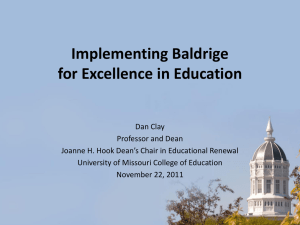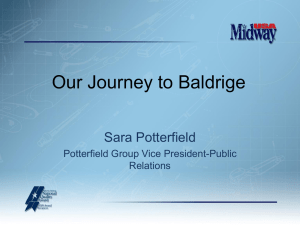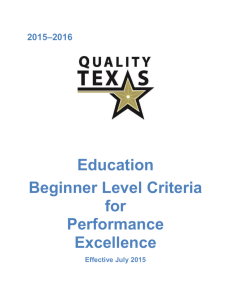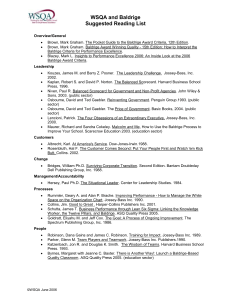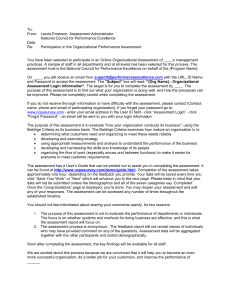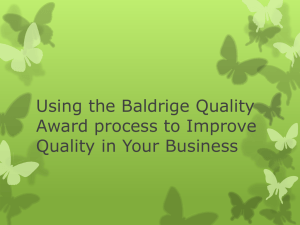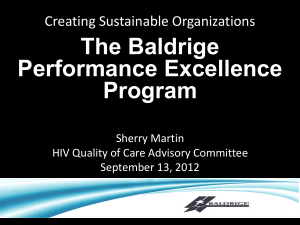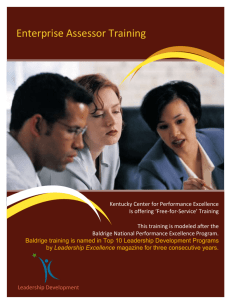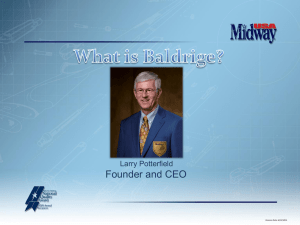Baldrige Excellence Builder - US Senate Productivity and Quality
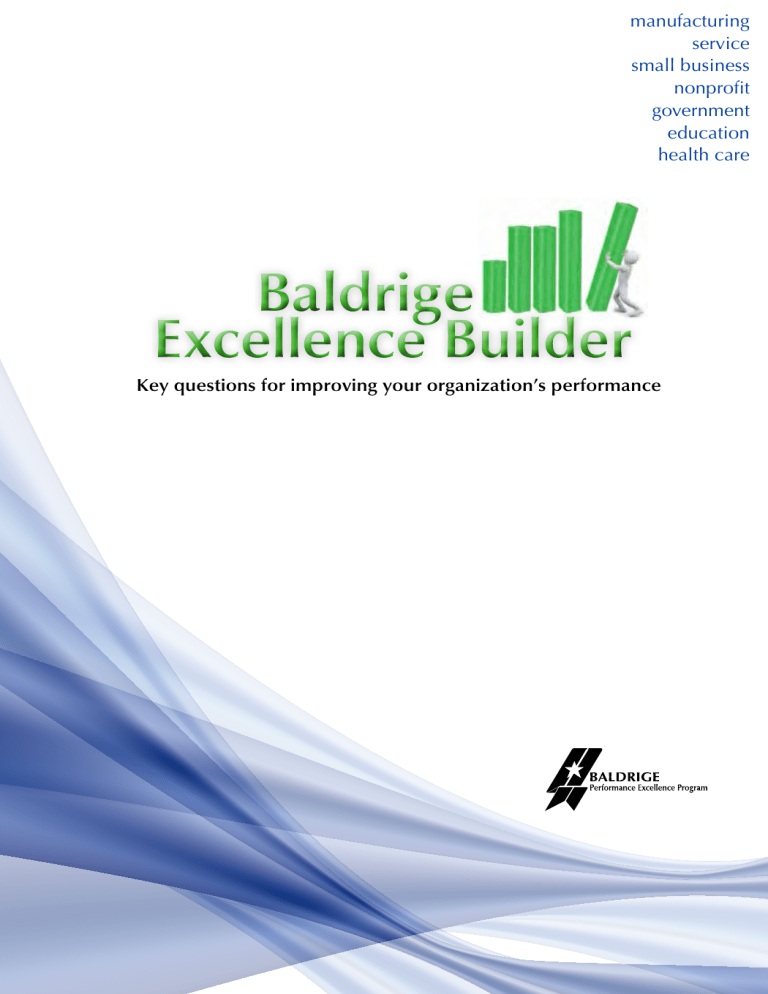
Baldrige
Excellence Builder
Key questions for improving your organization’s performance manufacturing service small business nonprofit government education health care
Improve Your Performance
The Baldrige Excellence Builder self-assessment helps you identify and improve what is critical to your organization’s success. By completing and acting on this assessment, you will be better positioned to accomplish your mission, improve your results, and become more competitive.
The Excellence Builder is based on the more detailed Baldrige Excellence Framework and its Criteria for Performance Excellence.
Here’s what the Baldrige Excellence Framework can do for you.
Government Agency
Achieved $3.22 billion in cost avoidance over
5 years
Manufacturer
Grew return on investment at a 23% compound annual rate; increased annual orders from repeat and international customers 32% and nearly 400%, respectively
Small Business
More than doubled in size over
6 years; created more than
$26 million in revenue annually for 9 years
Organizational Profile
Strategy Workforce
Leadership Integration
RESULTS
Customers Operations
Measurement, Analysis, and Knowledge Management
Hospital
Decreased the risk-adjusted mortality rate by 24%— better than the top-decile level in its six-county region
Core Values and Concepts
K–12 Public School System
Over 10 years, tripled the number of
Advanced Placement exams taken, with
66% of students taking at least one; more than doubled the number of AP exams with scores of 3 or higher
Nonprofit
Leads all local competitors in customer engagement and loyalty as measured by Net
Promoter System scores
Purchase your copy of the Baldrige Excellence Framework today.
http://www.nist.gov/baldrige/publications/purchase_criteria.cfm
Contents
2 About the Baldrige Excellence Builder
The Baldrige Excellence Builder represents the leading edge of validated leadership and performance practice.
5 Baldrige Excellence Builder
Assess your organization against the most important features of organizational excellence.
14 Evaluating Your Responses
Evaluate your answers to the Baldrige Excellence Builder questions.
16 Glossary of Key Terms
Learn the definitions of key terms in the Baldrige Excellence Builder.
I see the Baldrige process as a powerful set of mechanisms for disciplined people engaged in disciplined thought and taking disciplined action to create great organizations that produce exceptional results.
—Jim Collins, author of Good to Great:
Why Some Companies Make the Leap . . . and Others Don’t
1
About the Baldrige Excellence Builder
Is your organization doing as well as it could? How do you know? What and how should your organization improve or change?
The Baldrige Excellence Builder helps you assess your organization’s strengths and opportunities for improvement against the most important features of organizational performance excellence. By completing and acting on this assessment, you will be better positioned to accomplish your mission, improve your results, and become more competitive.
The Excellence Builder is based on the more detailed Baldrige Excellence Framework and its
Criteria for Performance Excellence (see http://www.nist.gov/baldrige/criteria.cfm). For more than 25 years, Baldrige has been globally recognized as the leading edge of validated leadership and performance practice.
Organizations around the world use the Baldrige framework to improve and get sustainable results. Those recognized as U.S. role models receive the Malcolm Baldrige National Quality
Award, a Presidential award. The recipients broadly share their best practices with others.
Through that sharing, many thousands of organizations have improved their operations and results, and thus their contributions to the U.S. and global economy.
A Focus on Improvement
The Baldrige Excellence Builder helps you understand how well you are achieving your goals and objectives:
• Are your processes consistently effective?
• Do your approaches address your organization’s needs?
• How good are your results?
• Is your organization learning, innovating, and improving?
As you answer the Excellence Builder questions and evaluate your responses, you will identify strengths and opportunities for improvement. Then, as you build on your strengths and address your opportunities, you create cycles of improvement within your organization.
A Focus on Core Values
The Baldrige framework and Baldrige Excellence Builder are based on the following core values and concepts. They represent beliefs and behaviors that are found in high-performing organizations:
• Systems perspective
• Visionary leadership
• Customer-focused excellence
• Valuing people
• Organizational learning and agility
• Focus on success
2 Baldrige Excellence Builder
• Managing for innovation
• Management by fact
• Societal responsibility
• Ethics and transparency
• Delivering value and results
These characteristics are embedded in the Excellence Builder questions. For an explanation of the core values and concepts, see the Baldrige Excellence Framework booklet (Business/
Nonprofit, Education, or Health Care; http://www.nist.gov/baldrige/publications/criteria.cfm).
A Systems Perspective
A systems perspective—the first core value—means managing all the parts of your organization as a unified whole to achieve your mission. It means ensuring that your plans, processes, measures, and actions are consistent. And it means ensuring that the individual parts of your organization’s management system work together in a fully interconnected, unified, and mutually beneficial manner.
The system’s building blocks are the core values and concepts above, the seven Baldrige Excellence Builder categories listed below, and the evaluation factors described below.
How to Use the Baldrige Excellence Builder
Answer the Organizational Profile questions.
Rather than prescribe how you should structure your organization or its operations or what its mission and goals should be, the
Baldrige Excellence Builder asks you to make those decisions. In the Organizational Profile
(pages 5–6), you define what is most relevant and important to your organization’s mission and performance.
The Organizational Profile sets the context for your answers to the rest of the Excellence
Builder questions. It can also serve as your first Baldrige self-assessment: if you identify topics for which you have conflicting, little, or no information, you can use those topics for action planning.
Answer the questions in categories 1–7 (pages 7–13). Your answers to these questions are an assessment against the most important features of organizational excellence. The categories represent seven critical aspects of managing and performing as an organization:
1. Leadership
2. Strategy
3. Customers
4. Measurement, analysis, and knowledge management
5. Workforce
6. Operations
7. Results
About the Baldrige Excellence Builder 3
4
Categories 1–6 (pages 7–12) each consist of two items (e.g., 1.1, 1.2), with many of the questions beginning with “how.” In answering these questions, give information on your key processes:
• Approach: How do you accomplish the work of your organization? How systematic are the key processes you use?
• Deployment: How consistently are your key processes used throughout your organization?
• Learning: Have you evaluated and improved your key processes? Have improvements been shared within your organization?
• Integration: How do your processes address your current and future organizational needs?
For the five items in category 7 (page 13), report on the results that are the most important to your organization’s success:
• Levels: What is your current performance?
• Trends: Are the results improving, staying the same, or getting worse?
• Comparisons: How does your performance compare with that of other organizations and competitors, or with benchmarks?
• Integration: Are you tracking results that are important to your organization? Are you using the results in organizational decision making?
Evaluate your answers: process and results.
Use the rubric on pages 14–15 to evaluate your answers to the Excellence Builder questions in each item. Identify your strengths. Then look at the next higher level to see what you might improve.
Prioritize your actions.
Celebrate your strengths and build on them to improve the things you do well. Sharing the things you do well with the rest of your organization can speed improvement. Also prioritize your opportunities for improvement; you cannot do everything at once. Think about what is most important for your organization at this time, and decide what to work on first. Develop an action plan, implement it, and measure your progress.
After you use the Excellence Builder, please e-mail us at baldrige@nist.gov to tell us about your experience.
Baldrige Excellence Builder
Baldrige Excellence Builder
The Baldrige Excellence Builder includes questions on the most important features of organizational excellence, starting with a full Organizational
Profile. For a more comprehensive set of questions, see the Baldrige Excellence
Framework booklet (Business/Nonprofit, Education, or Health Care; http:// www.nist.gov/baldrige/publications/criteria.cfm).
P
Organizational Profile
P.1 Organizational Description: What are your key organizational characteristics?
a. Organizational Environment
(1) Product Offerings What are your main product offerings*? What is the relative importance of each to your success? What mechanisms do you use to deliver your products?
(2) M ission , V ision , and V alues What are your stated mission , vision , and values ?
What are your organization’s core competencies , and what is their relationship to your mission ?
(3) W orkforce Profile What is your workforce profile? What recent changes have you experienced in workforce composition or your workforce needs? What are
• your workforce or employee groups and segments ,
• the educational requirements for different employee groups and segments , and
• the key drivers that engage them in achieving your mission and vision ?
What are your organized bargaining units (union representation)? What are your organization’s special health and safety requirements?
(4) Assets What are your major facilities, technologies, and equipment?
(5) Regulatory Requirements What is the regulatory environment under which you operate? What are the key applicable occupational health and safety regulations; accreditation, certification, or registration requirements; industry standards; and environmental, financial, and product regulations?
b. Organizational Relationships
(1) Organizational Structure What are your organizational structure and governance system? What are the reporting relationships among your governance board, senior leaders , and parent organization, as appropriate?
(Continued on the next page)
*For health care organizations, “product offerings” are health care services.
For education organizations, “product offerings” are educational programs and services.
See http://www.nist.gov/baldrige/publications/criteria.cfm for Baldrige frameworks tailored to the health care and
education sectors.
Baldrige Excellence Builder 5
(2) c ustoMers ** and s takeholders What are your key market segments , customer groups, and stakeholder groups, as appropriate? What are their key requirements and expectations for your products, customer support services, and operations? What are the differences in these requirements and expectations among market segments , customer groups, and stakeholder groups?
(3) Suppliers and P artners What are your key types of suppliers, partners , and collaborators ? What role do they play
• in your work systems , especially in producing and delivering your key products and customer support services; and
• in enhancing your competitiveness?
What are your key mechanisms for two-way communication with suppliers, partners , and collaborators ? What role, if any, do these organizations play in contributing and implementing innovations in your organization? What are your key supply-chain requirements?
P.2 Organizational Situation: What is your organization’s strategic situation?
a. Competitive Environment
(1) Competitive Position What is your competitive position? What are your relative size and growth in your industry or the markets you serve? How many and what types of competitors do you have?
(2) Competitiveness Changes What key changes, if any, are affecting your competitive situation, including changes that create opportunities for innovation and collaboration, as appropriate?
(3) Comparative Data What key sources of comparative and competitive data are available from within your industry? What key sources of comparative data are available from outside your industry? What limitations, if any, affect your ability to obtain or use these data?
b. Strategic Context
What are your key strategic challenges and advantages in the areas of business, operations, societal responsibilities, and workforce ? c. P erforMance Improvement System
What are the key elements of your performance improvement system, including your processes for evaluation and improvement of key organizational projects and processes ?
Terms in small caps are defined in the Glossary of Key Terms (pages 16–18).
**For health care organizations, “customers” are the users of your health care services (e.g., patients, families, insurers, and other third-party payors).
For education organizations, “customers” are the users of your educational programs and services (e.g., students and parents).
6 Baldrige Excellence Builder
1
Leadership
1.1 Senior Leadership: How do your senior leaders lead the organization?
(1) h ow do senior leaders set your organization’s vision and values ?
(2) h ow do senior leaders ’ actions demonstrate their commitment to legal and ethical behavior ?
(3) h ow do senior leaders ’ actions build an organization that is successful now and in the future?
(4) h ow do senior leaders communicate with and engage the entire workforce and key customers ?
(5) h ow do senior leaders create a focus on action that will achieve the organization’s mission ?
1.2 Governance and Societal Responsibilities: How do you govern your organization and fulfill your societal responsibilities?
(1) h ow does your organization ensure responsible governance ?
(2) h ow do you evaluate the performance of your senior leaders , including the chief executive, and your governance board?
(3) h ow do you anticipate and address public concerns with your products and operations?
(4) h ow do you promote and ensure ethical behavior in all interactions?
(5) h ow do you consider societal well-being and benefit as part of your strategy and daily operations?
(6) h ow do you actively support and strengthen your key communities?
Terms in small caps are defined in the Glossary of Key Terms (pages 16–18).
Baldrige Excellence Builder 7
2
Strategy
2.1 Strategy Development: How do you develop your strategy?
(1) h ow do you conduct your strategic planning?
(2) h ow does your strategy development process stimulate and incorporate innovation ?
(3) h ow do you collect and analyze relevant data and develop information for your strategic planning process ?
(4) What are your key work systems ?
(5) What are your organization’s key strategic objectives and timetable for achieving them?
(6) h ow do your strategic objectives achieve appropriate balance among varying and potentially competing organizational needs?
2.2 Strategy Implementation: How do you implement your strategy?
(1) What are your key short- and longer-term action plans ?
(2) h ow do you deploy your action plans ?
(3) h ow do you ensure that financial and other resources are available to support the achievement of your action plans while you meet current obligations?
(4) What are your key workforce plans to support your short- and longer-term strategic objectives and action plans ?
(5) What key performance measures or indicators do you use to track the achievement and effectiveness of your action plans ?
(6) For these key performance measures or indicators , what are your performance projections for your short- and longer-term planning horizons?
(7) h ow do you establish and implement modified action plans if circumstances require a shift in plans and rapid execution of new plans?
Terms in small caps are defined in the Glossary of Key Terms (pages 16–18).
8 Baldrige Excellence Builder
3
Customers
3.1 Voice of the Customer: How do you obtain information from your customers?
(1) h ow do you listen to, interact with, and observe customers * to obtain actionable information?
(2) h ow do you listen to potential customers to obtain actionable information?
(3) h ow do you determine customer satisfaction, dissatisfaction, and engagement ?
(4) h ow do you obtain information on customers ’ satisfaction with your organization relative to other organizations?
3.2 Customer Engagement: How do you engage customers by serving their needs and building relationships?
(1) h ow do you determine product offerings?
(2) h ow do you enable customers to seek information and support?
(3) h ow do you determine your customer groups and market segments ?
(4) h ow do you build and manage customer relationships?
(5) h ow do you manage customer complaints?
Terms in small caps are defined in the Glossary of Key Terms (pages 16–18).
*For health care organizations, “customers” are the users of your health care services (e.g., patients, families, insurers, and other third-party payors).
For education organizations, “customers” are the users of your educational programs and services (e.g., students and parents).
Baldrige Excellence Builder 9
4
Measurement, Analysis, and
Knowledge Management
4.1 Measurement, Analysis, and Improvement of
Organizational Performance: How do you measure, analyze, and then improve organizational performance?
(1) h ow do you use data and information to track daily operations and overall organizational performance ?
(2) h ow do you select and effectively use comparative data and information?
(3) h ow do you use voice of the customer and market data and information?
(4) h ow do you ensure that your performance measurement system can respond to rapid or unexpected organizational or external changes?
(5) h ow do you review your organization’s performance and capabilities?
(6) h ow do you share best practices in your organization?
(7) h ow do you project your organization’s future performance ?
(8) h ow do you use findings from performance reviews (addressed in question 5) to develop priorities for continuous improvement and opportunities for innovation ?
4.2 Knowledge Management, Information, and Information Technology:
How do you manage your organizational knowledge assets, information, and information technology infrastructure?
(1) h ow do you manage organizational knowledge?
(2) h ow do you use your knowledge and resources to embed learning in the way your organization operates?
(3) h ow do you verify and ensure the quality of organizational data and information?
(4) h ow do you ensure the security of sensitive or privileged data and information?
(5) h ow do you ensure the availability of organizational data and information?
(6) h ow do you ensure that hardware and software are reliable, secure, and user-friendly?
(7) In the event of an emergency, how do you ensure that hardware and software systems and data and information continue to be secure and available to effectively serve customers and business needs?
Terms in small caps are defined in the Glossary of Key Terms (pages 16–18).
10 Baldrige Excellence Builder
5
Workforce
5.1 Workforce Environment: How do you build an effective and supportive workforce environment?
(1) h ow do you assess your workforce capability and capacity needs?
(2) h ow do you recruit, hire, place, and retain new workforce members?
(3) h ow do you organize and manage your workforce ?
(4) h ow do you prepare your workforce for changing capability and capacity needs?
(5) h ow do you ensure workplace health, security, and accessibility for the workforce ?
(6) h ow do you support your workforce via services, benefits, and policies?
5.2 Workforce Engagement: How do you engage your workforce to achieve a high-performance work environment?
(1) h ow do you foster an organizational culture that is characterized by open communication, high performance , and an engaged workforce ?
(2) h ow do you determine the key drivers of workforce engagement ?
(3) h ow do you assess workforce engagement ?
(4) h ow does your workforce performance management system support high performance and workforce engagement ?
(5) h ow does your learning and development system support the organization’s needs and the personal development of your workforce members, managers, and leaders?
(6) h ow do you evaluate the effectiveness and efficiency of your learning and development system?
(7) h ow do you manage career progression for your organization?
Terms in small caps are defined in the Glossary of Key Terms (pages 16–18).
Baldrige Excellence Builder 11
6
Operations
6.1 Work Processes: How do you design, manage, and improve your key products and work processes?
(1) h ow do you determine key product* and work process requirements?
(2) h ow do you design your products and work processes to meet requirements?
(3) h ow does your day-to-day operation of work processes ensure that they meet key process requirements?
(4) h ow do you determine your key support processes ?
(5) h ow do you improve your work processes to improve products and performance , enhance your core competencies , and reduce variability?
(6) h ow do you manage for innovation ?
6.2 Operational Effectiveness: How do you ensure effective management of your operations?
(1) h ow do you control the overall costs of your operations?
(2) h ow do you manage your supply chain?
(3) h ow do you provide a safe operating environment?
(4) h ow do you ensure that your organization is prepared for disasters or emergencies?
Terms in small caps are defined in the Glossary of Key Terms (pages 16–18).
*For health care organizations, “products” are health care services.
For education organizations, “products” are educational programs and services.
See http://www.nist.gov/baldrige/publications/criteria.cfm for Baldrige frameworks tailored to the health care and
education sectors.
12 Baldrige Excellence Builder
7
Results
7.1 Product and Process Results: What are your product performance and process effectiveness results?
(1) What are your results for your products and your customer service processes?
(2) What are your process effectiveness and efficiency results ?
(3) What are your emergency preparedness results ?
(4) What are your supply-chain management results ?
7.2 Customer-Focused Results: What are your customer-focused performance results?
(1) What are your customer satisfaction and dissatisfaction results ?
(2) What are your customer engagement results ?
7.3 Workforce-Focused Results: What are your workforce-focused performance results?
(1) What are your workforce capability and capacity results ?
(2) What are your workforce climate results ?
(3) What are your workforce engagement results ?
(4) What are your workforce and leader development results ?
7.4 Leadership and Governance Results: What are your senior leadership and governance results?
(1) What are your results for senior leaders ’ communication and engagement with the workforce and customers ?
(2) What are your results for governance accountability?
(3) What are your legal and regulatory results ?
(4) What are your results for ethical behavior ?
(5) What are your results for societal responsibilities and support of your key communities?
(6) What are your results for the achievement of your organizational strategy and action plans ?
7.5 Financial and Market Results: What are your financial and marketplace performance results?
(1) What are your financial performance results ?
(2) What are your marketplace performance results ?
Terms in small caps are defined in the Glossary of Key Terms (pages 16–18).
Baldrige Excellence Builder 13
Evaluating Your Responses
For a more detailed scoring rubric, see the Baldrige Excellence Framework booklet (Business/Nonprofit, Education, or Health Care (http://www.nist.gov
/baldrige/publications/criteria.cfm).
Assessing Processes
Processes are the methods your organization uses and improves to do its work. The four factors used to evaluate processes are approach, deployment, learning, and integration (see page 4).
For process items (those in categories 1–6), read the process scoring rubric on page 15. For each item, assign one of the descriptors (Reactive, Early, Mature, or Role Model) based on a holistic assessment of your processes.
Assessing Results
Results are the outputs and outcomes your organization achieves. The four factors used to evaluate results are levels, trends, comparisons, and integration (see page 4).
For results items (7.1–7.5), read the results scoring rubric on page 15. For each item, assign one of the descriptors based on a holistic assessment of your overall performance.
14 Baldrige Excellence Builder
Evaluating Your Responses 15
Glossary of Key Terms
The terms below are those in small caps in the Baldrige Excellence Builder, as well as terms in the scoring rubric. For additional definitions and examples, see the Baldrige Excellence Framework booklet (Business/Nonprofit, Education, or Health Care; http://www.nist.gov/baldrige/publications/criteria.cfm).
ACTION PLANS.
Specific actions that your organization takes to reach its short- and longer-term strategic objectives. These plans specify the resources committed to and the time horizons for accomplishing the plans. See also strategic objectives .
ALIGNMENT.
A state of consistency among plans, processes, information, resource decisions, workforce capability and capacity, actions, results, and analyses that support key organization-wide goals. See also integration .
APPROACH.
The methods your organization uses to carry out its processes.
BENCHMARKS.
Processes and results that represent the best practices and best performance for similar activities, inside or outside your organization’s industry.
COLLABORATORS.
Organizations or individuals who cooperate with your organization to support a particular activity or event or who cooperate intermittently when their short-term goals are aligned with or are the same as yours.
See also partners .
CORE COMPETENCIES.
Your organization’s areas of greatest expertise; those strategically important capabilities that are central to fulfilling your mission or that provide an advantage in your marketplace or service environment.
CUSTOMER.
An actual or potential user of your organization’s products, programs, or services.
See also stakeholders .
CUSTOMER ENGAGEMENT.
Your customers’ investment in or commitment to your brand and product offerings.
16
DEPLOYMENT.
The extent to which your organization applies an approach in relevant work units throughout your organization.
EFFECTIVE.
How well a process or a measure addresses its intended purpose.
ETHICAL BEHAVIOR.
The actions your organization takes to ensure that all its decisions, actions, and stakeholder interactions conform to its moral and professional principles of conduct.
These principles should support all applicable laws and regulations and are the foundation for your organization’s culture and values.
EXCELLENCE.
See performance excellence .
GOALS.
Future conditions or performance levels that your organization intends or desires to attain. See also performance projections .
GOVERNANCE.
The system of management and controls exercised in the stewardship of your organization.
HIGH PERFORMANCE.
Ever-higher levels of overall organizational and individual performance, including quality, productivity, innovation rate, and cycle time.
HOW.
The systems and processes that your organization uses to achieve its mission requirements.
INNOVATION.
Making meaningful change to improve products, processes, or organizational effectiveness and create new value for stakeholders. The outcome of innovation is a discontinuous or breakthrough change.
INTEGRATION.
The harmonization of plans, processes, information, resource decisions, workforce capability and capacity, actions, results, and
Baldrige Excellence Builder
analyses to support key organization-wide goals.
See also alignment .
KEY.
Major or most important; critical to achieving your intended outcome.
KNOWLEDGE ASSETS.
Your organization’s accumulated intellectual resources; the knowledge possessed by your organization and its workforce in the form of information, ideas, learning, understanding, memory, insights, cognitive and technical skills, and capabilities.
LEARNING.
New knowledge or skills acquired through evaluation, study, experience, and innovation.
LEVELS.
Numerical information that places or positions your organization’s results and performance on a meaningful measurement scale.
MEASURES AND INDICATORS.
Numerical information that quantifies the input, output, and performance dimensions of processes, products, programs, projects, services, and the overall organization (outcomes).
MISSION.
Your organization’s overall function.
PARTNERS.
Key organizations or individuals who are working in concert with your organization to achieve a common goal or improve performance. Typically, partnerships are formal arrangements. See also collaborators .
PERFORMANCE.
Outputs and their outcomes obtained from processes, products, and customers that permit you to evaluate and compare your organization’s results to performance projections, standards, past results, goals, and other organizations’ results.
PERFORMANCE EXCELLENCE.
An integrated approach to organizational performance management that results in (1) delivery of everimproving value to customers and stakeholders, contributing to ongoing organizational success;
(2) improvement of your organization’s overall effectiveness and capabilities; and (3) learning for the organization and for people in the workforce.
Glossary of Key Terms
PERFORMANCE PROJECTIONS.
Estimates of your organization’s future performance. See also goals .
PROCESS.
Linked activities with the purpose of producing a product or service for a customer
(user) within or outside your organization.
RESULTS.
Outputs and outcomes achieved by your organization.
SEGMENT.
One part of your organization’s customer, market, product offering, or workforce base.
SENIOR LEADERS.
Your organization’s senior management group or team.
STRATEGIC ADVANTAGES.
Those marketplace benefits that exert a decisive influence on your organization’s likelihood of future success. These advantages are frequently sources of current and future competitive success relative to other providers of similar products.
STRATEGIC CHALLENGES.
Those pressures that exert a decisive influence on your organization’s likelihood of future success. These challenges are frequently driven by your organization’s anticipated competitive position in the future relative to other providers of similar products.
STRATEGIC OBJECTIVES.
The aims or responses that your organization articulates to address major change or improvement, competitiveness or social issues, and business advantages. See also action plans .
SYSTEMATIC.
Well-ordered, repeatable, and exhibiting the use of data and information so that learning is possible.
TRENDS.
Numerical information that shows the direction and rate of change of your organization’s results or the consistency of its performance over time.
VALUE.
The perceived worth of a product, process, asset, or function relative to its cost and possible alternatives.
VALUES.
The guiding principles and behaviors that embody how your organization and its people are expected to operate.
17
VISION.
Your organization’s desired future state.
VOICE OF THE CUSTOMER.
Your process for capturing customer-related information.
WORK PROCESSES.
Your organization’s most important internal value-creation processes.
WORK SYSTEMS.
How your organization’s work is accomplished, consisting of the internal work processes and external resources you need to develop and produce products, deliver them to your customers, and succeed in your marketplace.
WORKFORCE.
All people actively supervised by your organization and involved in accomplishing your organization’s work, including paid employees (e.g., permanent, part-time, temporary, and telecommuting employees, as well as contract employees supervised by your organization) and volunteers, as appropriate.
WORKFORCE CAPABILITY.
Your organization’s ability to accomplish its work processes through its people’s knowledge, skills, abilities, and competencies.
WORKFORCE CAPACITY.
Your organization’s ability to ensure sufficient staffing levels to accomplish its work processes and deliver your products to customers, including the ability to meet seasonal or varying demand levels.
WORKFORCE ENGAGEMENT.
The extent of workforce members’ emotional and intellectual commitment to accomplishing your organization’s work, mission, and vision.
18 Baldrige Excellence Builder
The Baldrige Program and Baldrige Foundation thank the
American Hospital Association as the lead sponsor for the
Health Care Criteria for Performance Excellence.
We also recognize the Lippincott Solutions team at Wolters Kluwer for sponsoring the Health Care Criteria.
BALDRIGE PERFORMANCE EXCELLENCE PROGRAM®, CRITERIA FOR PERFORMANCE EXCELLENCE®,
MALCOLM BALDRIGE NATIONAL QUALITY AWARD®, PERFORMANCE EXCELLENCE®, and THE QUEST
FOR EXCELLENCE® are federally registered trademarks and service marks of the U.S. Department of
Commerce, National Institute of Standards and Technology. The unauthorized use of these trademarks and service marks is prohibited.
You’ve used the Baldrige Excellence Builder to assess your organization.
What’s next?
a
Purchase the Framework Booklet
The Baldrige Excellence Framework (Business/Nonprofit, Education, or Health Care) is a more comprehensive guide to organizational performance excellence.
a
Attend Baldrige Conferences
At a Baldrige Quest or Regional Conference, you will learn best performance management practices from Baldrige Award recipients. a
Attend the Baldrige Examiner Training Experience
In this nationally recognized Baldrige Examiner Training course, you will work side-by-side with experienced Baldrige examiners and learn how to use the Criteria for
Performance Excellence via the training’s peer-driven, case-study-based approach.
a
Apply for the Baldrige Executive Fellows Program
This one-year, nationally ranked leadership development experience is for direct reports to the most senior leader in the organization or business unit leaders. It prepares this elite group of rising senior executives for impactful leadership and for achieving performance excellence in their own organizations. a
Request a Baldrige Collaborative Assessment
An assessment against the Baldrige Criteria by a team of experienced Baldrige examiners gives you timely, actionable feedback that you can begin using right away to improve your organization. The end product is immediate feedback on your organization’s areas of strength and opportunities for improvement, followed by a written feedback report.
a
Get Involved
Your state, local, or sector-specific Baldrige-based program can provide other assessment and training options (see the Alliance for Performance Excellence, http://www.baldrigepe.org/alliance).
a
Contact the Baldrige Program
We’ll answer your questions about Baldrige products and services.
a powerful set of mechanisms
Jim Collins, author of Good to Great: Why Some Companies Make the Leap . . . and Others Don’t
I see the Baldrige process as a powerful set of mechanisms for disciplined people engaged in disciplined thought and taking disciplined action to create great organizations that produce exceptional results.
Purchase your copy of the Baldrige Excellence Framework today.
http://www.nist.gov/baldrige/publications/purchase_criteria.cfm
Printed format: $25
Electronic format: $10
Volume discounts and enterprise licenses available
Contents
About the Baldrige Excellence Framework
How to Use the Baldrige Excellence Framework
Criteria for Performance Excellence
Scoring System
How to Respond to the Criteria
Core Values and Concepts
Changes from the 2013–2014 Criteria
Glossary of Key Terms
Contact
For more information on the Baldrige Excellence Framework or other products and services: www.nist.gov/baldrige | 301.975.2036 | baldrige@nist.gov
01/2015
T1544
